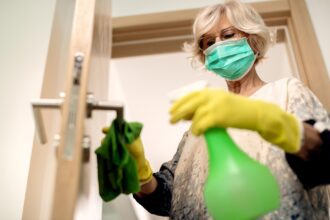As the world shifts towards a more sustainable future, eco-friendly businesses are gaining popularity. One crucial aspect of maintaining an environmentally responsible business is adopting green cleaning solutions. In this article, we’ll delve into the importance of green cleaning, its benefits, and explore effective eco-friendly alternatives to traditional cleaning products.
The Importance of Green Cleaning
Conventional cleaning products contain harsh chemicals that harm the environment and human health. Moreover, these chemicals contaminate waterways, soil, and air, contributing to climate change. In contrast, green cleaning solutions are made from natural ingredients, biodegradable, and non-toxic. By adopting eco-friendly cleaning practices, businesses can significantly reduce their ecological footprint.
Benefits of Green Cleaning for Businesses
Not only do green cleaning solutions benefit the environment, but they also offer numerous advantages for businesses. Some key benefits include:
- Cost savings: Eco-friendly cleaning products are often cheaper than traditional alternatives.
- Improved brand reputation: Adopting sustainable practices enhances a company’s reputation and attracts environmentally conscious customers.
- Healthier work environments: Green cleaning solutions reduce exposure to toxic chemicals, creating a healthier workplace for employees.
Effective Eco-Friendly Cleaning Alternatives
Fortunately, there are numerous effective eco-friendly cleaning alternatives available. Some popular options include:
- Baking soda and vinegar: A natural combination for cleaning surfaces and removing stains.
- Castile soap: A biodegradable and non-toxic soap made from olive oil.
- Essential oils: Certain essential oils, such as tea tree oil and lemon oil, possess antibacterial properties.
Green Cleaning Solutions for Common Business Areas
Different business areas require specialized cleaning solutions. Here are some eco-friendly options for common areas:
- Office spaces: Use microfiber cloths with water or a mixture of castile soap and water to clean surfaces.
- Restrooms: Implement a toilet cleaning system using natural enzymes and bacteria to break down waste.
- Kitchens: Utilize compostable cleaning wipes or a combination of baking soda and vinegar to sanitize surfaces.
Creating an Eco-Friendly Cleaning Policy
To ensure a successful transition to green cleaning solutions, businesses must establish a comprehensive cleaning policy. This should include:
- Staff training: Educate employees on the importance of eco-friendly cleaning practices and provide guidance on using new products.
- Product procurement: Source cleaning products from reputable suppliers that adhere to environmental standards.
- Waste management: Implement recycling programs for packaging materials and dispose of hazardous waste responsibly.
Overcoming Challenges in Green Cleaning
While adopting green cleaning solutions offers numerous benefits, businesses may encounter challenges. Some common obstacles include:
- Higher upfront costs: Although eco-friendly products can be more expensive initially, they often provide long-term cost savings.
- Employee resistance to change: Educate staff on the importance of sustainable practices and involve them in the transition process.
Green Cleaning Certifications and Standards
To ensure authenticity, businesses can obtain certifications from reputable organizations. Some prominent green cleaning certifications include:
- EcoLogo: A certification program that verifies products meet rigorous environmental standards.
- Safer Choice: A label awarded to products that meet EPA’s stringent safety criteria.
Adopting green cleaning solutions is a crucial step towards maintaining an eco-friendly business. By understanding the importance of sustainable cleaning practices, leveraging effective eco-friendly alternatives, and creating a comprehensive cleaning policy, businesses can significantly reduce their environmental impact while improving their reputation and bottom line.
